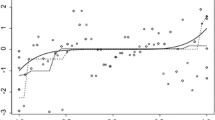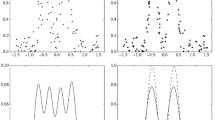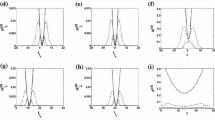Abstract
Asymptotically correct simultaneous confidence bands (SCBs) are proposed in both multiplicative and additive form to compare variance functions of two samples in the nonparametric regression model based on deterministic designs. The multiplicative SCB is based on two-step estimation of ratio of the variance functions, which is as efficient, up to order \(n^{-1/2}\), as an infeasible estimator if the two mean functions are known a priori. The additive SCB, which is the log transform of the multiplicative SCB, is location and scale invariant in the sense that the width of SCB is free of the unknown mean and variance functions of both samples. Simulation experiments provide strong evidence that corroborates the asymptotic theory. The proposed SCBs are used to analyze several strata pressure data sets from the Bullianta Coal Mine in Erdos City, Inner Mongolia, China.



Similar content being viewed by others
References
Bose S, Mahalanobis P (1935) On the distribution of the ratio of variances of two samples drawn from a given normal bivariate correlated population. Sankhyā Indian J Stat 2:65–72
Bickel P, Rosenblatt M (1973) On some global measures of deviations of density function estimates. Ann Stat 31:1852–1884
Brown L, Levine M (2007) Variance estimation in nonparametric regression via the difference sequence method. Ann Stat 35:2219–2232
Claeskens G, Van Keilegom I (2003) Bootstrap confidence bands for regression curves and their derivatives. Ann Stat 31:1852–1884
Cai L, Yang L (2015) A smooth simultaneous confidence band for conditional variance function. TEST 24:632–655
Cai L, Liu R, Wang S, Yang L (2019) Simutaneous confidence bands for mean and varience functions based on deterministic design. Stat Sin 29:505–525
Cai L, Li L, Huang S, Ma L, Yang L (2020) Oracally efficient estimation for dense functional data with holiday effects. TEST 29:282–306
Cao G, Wang L, Li Y, Yang L (2016) Oracle-efficient confidence envelopes for covariance functions in dense functional data. Stat Sin 26:359–383
Cao G, Yang L, Todem D (2012) Simultaneous inference for the mean function based on dense functional data. J Nonparametr Stat 24:359–377
Degras D (2011) Simultaneous confidence bands for nonparametric regression with functional data. Stat Sin 21:1735–1765
de Boor C (2001) A Practical Guide to Splines. Springer, New York
Eubank R, Speckman P (1993) Confidence bands in nonparametric regression. J Am Stat Assoc 88:1287–1301
Finney D (1938) The distribution of the ratio of estimates of the two variances in a sample from a normal bi-variate population. Biometrika 30:190–192
Fisher R (1924) On a distribution yielding the error function of several well known statistics. Proc Int Congr Math 2:805–813
Fan J, Gijbels I (1996) Local Polynomial Modelling and Its Applications. Chapman and Hall, London
Gayen A (1950) The distribution of the variance ratio in random samples of any size drawn from non-normal universes. Biometrika 37:236–255
Gu L, Wang L, Härdle W, Yang L (2014) A simultaneous confidence corridor for varying coefficient regression with sparse functional data. TEST 23:806–843
Gu L, Yang L (2015) Oracally efficient estimation for single-index link function with simultaneous confidence band. Electron J Stat 9:1540–1561
Gu L, Wang S, Yang L (2019) Simultaneous confidence bands for the distribution function of a finite population in stratified sampling. Ann Inst Stat Math 71:983–1005
Härdle W (1989) Asmptotic maximal deviation of M-smoothers. J Multivar Anal 29:163–179
Härdle W, Marron J (1991) Bootstrap simultaneous error bars for nonparametric regression. Ann Stat 19:778–796
Hall P, Titterington D (1988) On confidence bands in nonparametric density estimation and regression. J Multivar Anal 27:228–254
James G (1951) The comparison of several groups of observations when the ratios of the population variances are unknown. Biometrika 38:324–329
Jiang J, Cai L, Yang L (2020) Simultaneous confidence band for the difference of regression functions of two samples. Commun Stat Theory Methods. https://doi.org/10.1080/03610926.2020.1800039
Johnston G (1982) Probabilities of maximal deviations for nonparametric regression function estimates. J Multivar Anal 12:402–414
Ju J, Xu J (2013) Structural characteristics of key strata and strata behaviour of a fully mechanized longwall face with 7.0m height chocks. Int J Rock Mech Min Sci 58:46–54
Leadbetter MR, Lindgren G, Rootzén H (1983) Extremes and related properties of random sequences and processes. Springer, New York
Levine M (2006) Bandwidth selection for a class of difference-based variance estimators in the nonparametric regression: a possible approach. Comput Stat Data Anal 50:3405–3431
Ma S, Yang L, Carroll R (2012) A simultaneous confidence band for sparse longitudinal regression. Stat Sin 22:95–122
Qian M, Shi P, Xu J (2010) Mining pressure and strata control. China University of Mining and Technology Press, Beijing
Scheffé H (1942) On the ratio of the variances of two normal populations. Ann Math Stat 13:371–388
Song Q, Yang L (2009) Spline confidence bands for variance functions. J Nonparametr Stat 5:589–609
Song Q, Liu R, Shao Q, Yang L (2014) A simultaneous confidence band for dense longitudinal regression. Commun Stat Theory Methods 43:5195–5210
Wang J, Yang L (2009) Polynomial spline confidence bands for regression curves. Stat Sin 19:325–342
Wang J (2012) Modelling time trend via spline confidence band. Ann Inst Stat Math 64:275–301
Wang J, Liu R, Cheng F, Yang L (2014) Oracally efficient estimation of autoregressive error distribution with simultaneous confidence band. Ann Stat 42:654–668
Wang J, Wang S, Yang L (2016) Simultaneous confidence bands for the distribution function of a finite population and its superpopulation. TEST 25:692–709
Welch B (1938) The significance of the difference between two means when the population variances are unequal. Biometrika 29:350–362
Xia Y (1998) Bias-corrected confidence bands in nonparametric regression. J R Stat Soc Ser B 60:797–811
Xue L, Yang L (2006) Additive coefficient modeling via polynomial spline. Stat Sin 16:1423–1446
Zhao Z, Wu W (2008) Confidence bands in nonparametric time series regression. Ann Stat 36:1854–1878
Zhang Y, Yang L (2018) A smooth simultaneous confidence band for correlation curve. TEST 27:247–269
Zheng S, Yang L, Härdle W (2014) A smooth simultaneous confidence corridor for the mean of sparse functional data. J Am Stat Assoc 109:661–673
Zheng S, Liu R, Yang L, Härdle W (2016) Statistical inference for generalized additive models:simultaneous confidence corridors and variable selection. TEST 25:607–626
Acknowledgements
This research is part of the first author’s dissertation under the supervision of the second author, and has been supported exclusively by National Natural Science Foundation of China award 11771240. The authors are grateful to Professor Yaodong Jiang for providing the strata pressure data, and two Reviewers for thoughtful comments.
Author information
Authors and Affiliations
Corresponding author
Additional information
Publisher's Note
Springer Nature remains neutral with regard to jurisdictional claims in published maps and institutional affiliations.
Appendix
Appendix
The following is a reformulation of Theorems 11.1.5 and 12.3.5 in Leadbetter et al. (1983).
Lemma 1
If a Gaussian process \(\varsigma \left( s\right) ,0\le s\le T\) is stationary with mean zero and variance one, and covariance function statisfying
for some constant \(C>0,0<\alpha \le 2.\) Then as \(T\rightarrow \infty \),
where \(a_{T}=\left( 2\log T\right) ^{1/2}\) and
with \(H_{1}=1,H_{2}=\pi ^{-1/2}\).
Lemmas 2–4 are from Cai et al. (2019).
Lemma 2
Under Assumption (A6), for \(s=1,2\), as \(n\rightarrow \infty \),
Lemma 3
Under Assumptions (A2), (A6) and (A7), for \(s=1,2\), as \( n\rightarrow \infty \),
Lemma 4
Under Assumptions (A2)–(A4), (A6), (A7), for \(s=1,2\), as \(n\rightarrow \infty ,\)
Denote
Lemma 5
Under Assumptions (A2)–(A4), (A6), (A7), as \( n\rightarrow \infty ,\)
Consequently,
where \(a_{h}\) and \(v_{n}\) are given in (5).
Proof According to Lemmas 2–4, one has
Now applying Taylor series expansions to \(\ln {\tilde{\sigma }}_{s}^{2}\left( x\right) -\ln \sigma _{s}^{2}\left( x\right) \), for \(s=1,2\)
Then one obtains
Since one has
and according to Lemmas 2–4, one has
Hence combining (14), (15) and (16), the proof is completed.
Denote the following processes
As \(\text{ E }\left\{ B_{n_{1},n_{2,}3}^{2}\left( x\right) \right\} =h^{-1}\left\{ n_{1}^{-1}\left( \mu _{1,4}-1\right) +n_{2}^{-1}\left( \mu _{2,4}-1\right) \right\} \int _{-1}^{1}K^{2}\left( u\right) du\), one obtains the following standard Gaussian processes,
where \(\nu _{1,4}=\mu _{1,4}-1\) and \(\nu _{2,4}=\mu _{2,4}-1\).
Another standard Gaussian process is
which is \(\zeta \left( x\right) \) defined in (10).
Lemma 6
The absolute maximum of the process \(\bigtriangleup _{1}\left( x\right) \) follows the same as that of \(\bigtriangleup _{2}\left( x\right) \), and the absolute maximum of the process \(\bigtriangleup _{2}\left( x\right) \) follows the same as that of \(\zeta \left( x\right) \), that is
Proof This lemma can be easily obtained by noting the fact that for \(s=1,2\), the process \(B_{n_{1},n_{2,}3}\left( x\right) ,x\in \left[ h,1-h\right] \) has the same probability law as \(Y_{1,n_{1},1}\left( x\right) -Y_{2,n_{2,}1}\left( x\right) ,x\in \left[ 1,h^{-1}-1\right] \), and the process \(Y_{s,n_{s},1}\left( x\right) ,x\in \left[ h,1-h\right] \) has the same probability law as \(Y_{s,n_{s},2}\left( x\right) ,x\in \left[ 1,h^{-1}-1\right] \).
Proof of Proposition 1
Proposition 1 is a direct corollary of Lemma 5, Lemma 6 and Proposition 3.
Proof of Proposition 2
According to Theorem 2 in Cai et al. (2019) and applying Taylor expansion, one has
which completes the proof.
Proof of Proposition 3
For Gaussian process \(\zeta \left( x\right) \), its correlation function is
which implies that
Define next a Gaussian process \(\varsigma \left( t\right) ,0\le t\le T=T_{n}=h^{-1}-2\),
which is stationary with mean zero and variance one, and covariance function
with \(C=\int _{-1}^{1}K^{\left( 1\right) }\left( u\right) ^{2}du/2\int _{-1}^{1}K^{2}\left( u\right) du\). Hence applying Lemmas 1–6, one has for \( h\rightarrow 0\) or \(T\rightarrow \infty ,\)
where \(a_{T}=\left( 2\log T\right) ^{1/2}\) and \(b_{T}=a_{T}+a_{T}^{-1}\left\{ 2^{-1}\mathrm {log}\left( C_{K}/\left( 4\pi ^{2}\right) \right) \right\} \) . Note that
Hence, applying Slutsky’s Theorem twice, one obtains that
which converges in distribution to the same limit as \(a_{T}\left\{ \sup _{t\in \left[ 0,T\right] }\left| \varsigma \left( t\right) \right| -b_{T}\right\} \). Thus
Hence the proof is completed.
Proof of Theorem 1
According to Proposition 1, as \(n\rightarrow \infty ,\)
where \(a_{h},b_{h}\) and \(v_{n}\) are given in (5). Finally applying Proposition 2, one obtains
Using Slutsky’s Theorem one can substitute \(\ln \frac{{\hat{\sigma }} _{1}^{2}\left( x\right) }{{\hat{\sigma }}_{2}^{2}\left( x\right) }\) for \(\ln \frac{{\tilde{\sigma }}_{1}^{2}\left( x\right) }{{\tilde{\sigma }}_{2}^{2}\left( x\right) }\) in (19). Hence the proof of Theorem 1 is completed.
Rights and permissions
About this article
Cite this article
Zhong, C., Yang, L. Simultaneous confidence bands for comparing variance functions of two samples based on deterministic designs. Comput Stat 36, 1197–1218 (2021). https://doi.org/10.1007/s00180-020-01043-6
Received:
Accepted:
Published:
Issue Date:
DOI: https://doi.org/10.1007/s00180-020-01043-6




